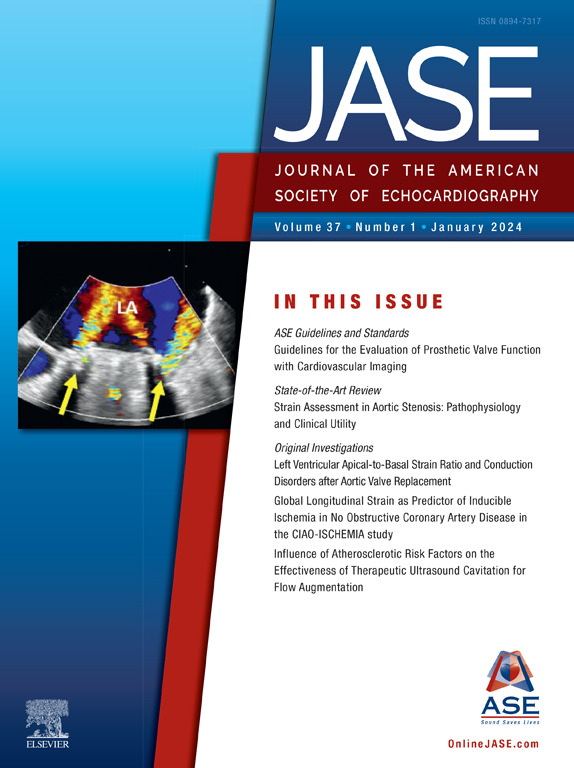Association of Impaired Relaxation Mitral Inflow Pattern (Grade 1 Diastolic Function) With Long-Term Noncardiovascular and Cardiovascular Mortality
IF 5.4
2区 医学
Q1 CARDIAC & CARDIOVASCULAR SYSTEMS
Journal of the American Society of Echocardiography
Pub Date : 2025-05-01
DOI:10.1016/j.echo.2025.01.005
引用次数: 0
Abstract
Background
Abnormalities of left ventricular diastolic function are established independent predictors of heart failure and mortality. The aim of this study was to determine whether the association of diastolic function with all-cause mortality is driven by cardiovascular or noncardiovascular death and if impaired relaxation mitral inflow filling pattern is a risk marker.
Methods
Diastolic function was graded by the Mayo Clinic algorithm using the well-characterized prospective Olmsted County Heart Function Study. Those with reduced left ventricular ejection fraction, moderate or greater valve disease, clinical diagnosis of heart failure, or indeterminate diastolic function were excluded. Notably, all patients with an impaired relaxation pattern (E/A ratio < 0.8) were classified as abnormal (grade 1) regardless of ejection fraction and clinical or other echocardiographic abnormalities. Individuals were followed for a median of 19.7 years (interquartile range, 18.9-20.6 years) for mortality outcomes.
Results
In a community cohort of 1,005 subjects 63 years (interquartile range, 57-71 years) of age, grade 1 diastolic function was common (26%) and associated with all-cause mortality (hazard ratio [HR], 4.05; 95% CI, 3.22-5.09; P < .0001). This association persisted in a subgroup of those with impaired myocardial relaxation and no other clinical or echocardiographic abnormalities (HR, 2.71; 95% CI, 1.89-3.88; P < .0001). The association of diastolic function with noncardiovascular death was not significant after adjustment for age, sex, and comorbidities, though there was an association with grade 1 diastolic function and risk for death of dementia (age- and sex-adjusted HR, 2.30; 95% CI, 1.54-3.45; P < .001). The association of diastolic function and cardiovascular mortality persisted in multivariable model, including for grade 1 diastolic function (HR, 2.43; 95% CI, 1.16-5.05; P = .02).
Conclusions
Impaired relaxation mitral inflow pattern (grade 1) is common in older adults in the community and found to be associated with cause-specific death, highlighting this simple echocardiographic finding as a potential biomarker of cardiovascular and cognitive risk and not necessarily a benign finding that is normal with age.
舒张二尖瓣流入模式受损(1级舒张功能)与长期非心血管和心血管死亡率的关系。
背景:左室(LV)舒张功能异常是心衰(HF)和死亡率的独立预测因素。目的:确定舒张功能与全因死亡率的关联是否由心血管或非心血管死亡驱动,以及舒张二尖瓣血流充盈模式受损是否是一个危险标志。方法:利用具有良好特征的前瞻性奥姆斯特德县心功能研究,采用梅奥诊所算法对舒张功能进行分级。排除左室射血分数(EF)降低、≥中度瓣膜疾病、临床诊断为心衰或舒张功能不确定的患者。结果:在1005名63(57-71)岁的社区队列中,1级舒张功能很常见(26%),并与全因死亡率相关(HR 4.05, 95% CI 3.22-5.09, p)。松弛二尖瓣流入模式受损(1级)在社区老年人中很常见,并被发现与原因特异性死亡有关,强调了这种简单的回声发现是心血管和认知风险的潜在生物标志物,而不一定是随年龄增长而正常的良性发现。
本文章由计算机程序翻译,如有差异,请以英文原文为准。
求助全文
约1分钟内获得全文
求助全文
来源期刊
CiteScore
9.50
自引率
12.30%
发文量
257
审稿时长
66 days
期刊介绍:
The Journal of the American Society of Echocardiography(JASE) brings physicians and sonographers peer-reviewed original investigations and state-of-the-art review articles that cover conventional clinical applications of cardiovascular ultrasound, as well as newer techniques with emerging clinical applications. These include three-dimensional echocardiography, strain and strain rate methods for evaluating cardiac mechanics and interventional applications.

 求助内容:
求助内容: 应助结果提醒方式:
应助结果提醒方式:


